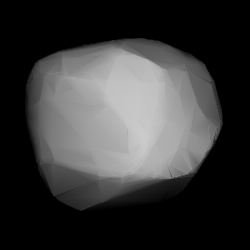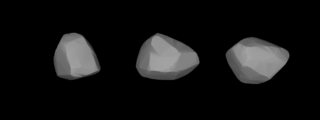Related Research Articles

62 Erato is a carbonaceous Themistian asteroid from the outer region of the asteroid belt, approximately 95 kilometers in diameter. Photometric measurements during 2004–2005 showed a rotation period of 9.2213±0.0007 h with an amplitude of 0.116±0.005 in magnitude. It is orbiting the Sun with a period of 5.52 yr, a semimajor axis of 3.122 AU, and eccentricity of 0.178. The orbital plane is inclined by an angle of 2.22° to the plane of the ecliptic.

100 Hekate is a large main-belt asteroid.

108 Hecuba is a fairly large and bright main-belt asteroid. It was discovered by Karl Theodor Robert Luther on 2 April 1869, and named after Hecuba, wife of King Priam in the legends of the Trojan War in Greek Mythology. This object is orbiting the Sun with a period of 5.83 years and an eccentricity of 0.06. It became the first asteroid discovered to orbit near a 2:1 mean-motion resonance with the planet Jupiter, and is the namesake of the Hecuba group of asteroids.

159 Aemilia is a large main-belt asteroid. Aemilia was discovered by the French brothers Paul Henry and Prosper Henry on January 26, 1876. The credit for this discovery was given to Paul. It is probably named after the Via Aemilia, a Roman road in Italy that runs from Piacenza to Rimini.

160 Una is a fairly large and dark, primitive Main belt asteroid that was discovered by German-American astronomer C. H. F. Peters on February 20, 1876, in Clinton, New York. It is named after a character in Edmund Spenser's epic poem The Faerie Queene (1590).

170 Maria is a Main belt asteroid that was discovered by French astronomer Henri Joseph Perrotin on January 10, 1877. Its orbit was computed by Antonio Abetti, and the asteroid was named after his sister, Maria. This is the namesake of the Maria asteroid family; one of the first asteroid families to be identified by Japanese astronomer Kiyotsugu Hirayama in 1918.
255 Oppavia is a sizeable Main belt asteroid. It was discovered by Austrian astronomer Johann Palisa on 31 March 1886 in Vienna and was named after Opava, a town in the Czech Republic, then part of Austria-Hungary, where Palisa was born. It is orbiting the Sun at a distance of 2.75 AU with an orbital eccentricity (ovalness) of 0.077 and a period of 4.55 yr. The orbital plane is inclined by an angle of 9.47° to the plane of the ecliptic.

258 Tyche is a relatively large main belt asteroid discovered by Robert Luther at Düsseldorf-Bilk Observatory on 4 May 1886. The stony S-type asteroid measures about 65 kilometers in diameter and has a perihelion of 2.1 AU.

281 Lucretia is an asteroid belonging to the Flora family in the Main Belt. It was discovered by Austrian astronomer Johann Palisa on 31 October 1888 in Vienna, and is named after the middle name of Caroline Herschel, one of the first female astronomers. Light curves of this asteroid show a synodic rotation period of 4.349±0.001 h with an amplitude of 0.3–0.4 magnitude. The spin axis appears nearly perpendicular to the ecliptic.

291 Alice is a stony background asteroid from the inner region of the asteroid belt. It was discovered by Johann Palisa on 25 April 1890 at the Vienna Observatory.

341 California is an asteroid belonging to the Flora family in the Main Belt. It was discovered by Max Wolf on 25 September 1892 in Heidelberg, and is named for the U.S. state of California. This object is orbiting the Sun at a distance of 2.20 AU with a period of 3.26 yr and an eccentricity (ovalness) of 0.19. The orbital plane is inclined at an angle of 5.7° to the plane of the ecliptic.

550 Senta is a minor planet orbiting the Sun that was discovered by German astronomer Max Wolf on 16 November 1904, from Heidelberg.
575 Renate is a minor planet, specifically an asteroid orbiting in the asteroid belt which was discovered by German astronomer Max Wolf on September 19, 1905. The name may have been inspired by the asteroid's provisional designation 1905 RE.
630 Euphemia is a mid-sized Eunomian asteroid.
742 Edisona is a minor planet, specifically an asteroid orbiting in the asteroid belt that was discovered by German astronomer Franz Kaiser on February 23, 1913. It was named for inventor Thomas Edison. This asteroid is orbiting 3.01 AU with a period of 5.22 years and an eccentricity of 0.119. The orbital plane is inclined at an angle of 11.2° to the plane of the ecliptic. This is a member of the dynamic Eos family of asteroids that most likely formed as the result of a collisional breakup of a parent body.
743 Eugenisis is a minor planet orbiting the Sun that was discovered by German astronomer Franz Kaiser in 1913.
774 Armor is a minor planet orbiting in the main belt. It was discovered on 13 December 1913, in Paris by French astronomer Charles le Morvan and was named after the Celtic region of Armorica. The asteroid is orbiting at a distance of 3.05 AU with a period of 5.32 yr and an eccentricity of 0.169. The orbital plane is inclined by an angle of 5.56° to the plane of the ecliptic.

867 Kovacia is an elongated, dark asteroid and member of the Hygiea family from the outer regions of the asteroid belt. It was discovered on 25 February 1917, by astronomer Johann Palisa at the Vienna Observatory in Austria. The carbonaceous C/B-type asteroid has a rotation period of 8.7 hours and measures approximately 24 kilometers in diameter. It was named after Austrian physician Friedrich Kovacs (1861–1931).
3628 Božněmcová, provisional designation 1979 WD, is a rare-type asteroid from the middle region of the asteroid belt, approximately 7 kilometers in diameter. It was discovered on 25 November 1979, by Czech astronomer Zdeňka Vávrová at Kleť Observatory in the Czech Republic. It is named for Czech writer Božena Němcová.

1996 PW is an exceptionally eccentric trans-Neptunian object and a damocloid on an orbit typical of long-period comets but one that showed no sign of cometary activity around the time it was discovered. The unusual object measures approximately 10 kilometers in diameter and has a rotation period of 35.4 hours and likely an elongated shape.
References
- ↑ (German Names)
- 1 2 3 4 "538 Friederike (1904 OK)". JPL Small-Body Database . NASA/Jet Propulsion Laboratory . Retrieved 8 May 2016.
- 1 2 "Supplemental IRAS Minor Planet Survey". Archived from the original on 19 January 2007.
- ↑ G. A. Krasinsky; et al. (2002). "Hidden Mass in the Asteroid Belt". Icarus. 158 (1): 98. Bibcode:2002Icar..158...98K. doi:10.1006/icar.2002.6837.
- ↑ "PDS lightcurve data". Archived from the original on 19 January 2007.
- ↑ T. Mothé-Diniz; et al. (2001). "Rotationally Resolved Spectra of 10 Hygiea and a Spectroscopic Study of the Hygiea Family". Icarus. 152 (1): 117. Bibcode:2001Icar..152..117M. doi:10.1006/icar.2001.6618.
- ↑ Pilcher, Frederick (April 2013), "Rotation Period Determinations for 24 Themis, 159 Aemilia 191 Kolga, 217 Eudora, 226 Weringia, 231 Vindobona, and 538 Friederike", The Minor Planet Bulletin, 40 (2): 85–87, Bibcode:2013MPBu...40...85P.